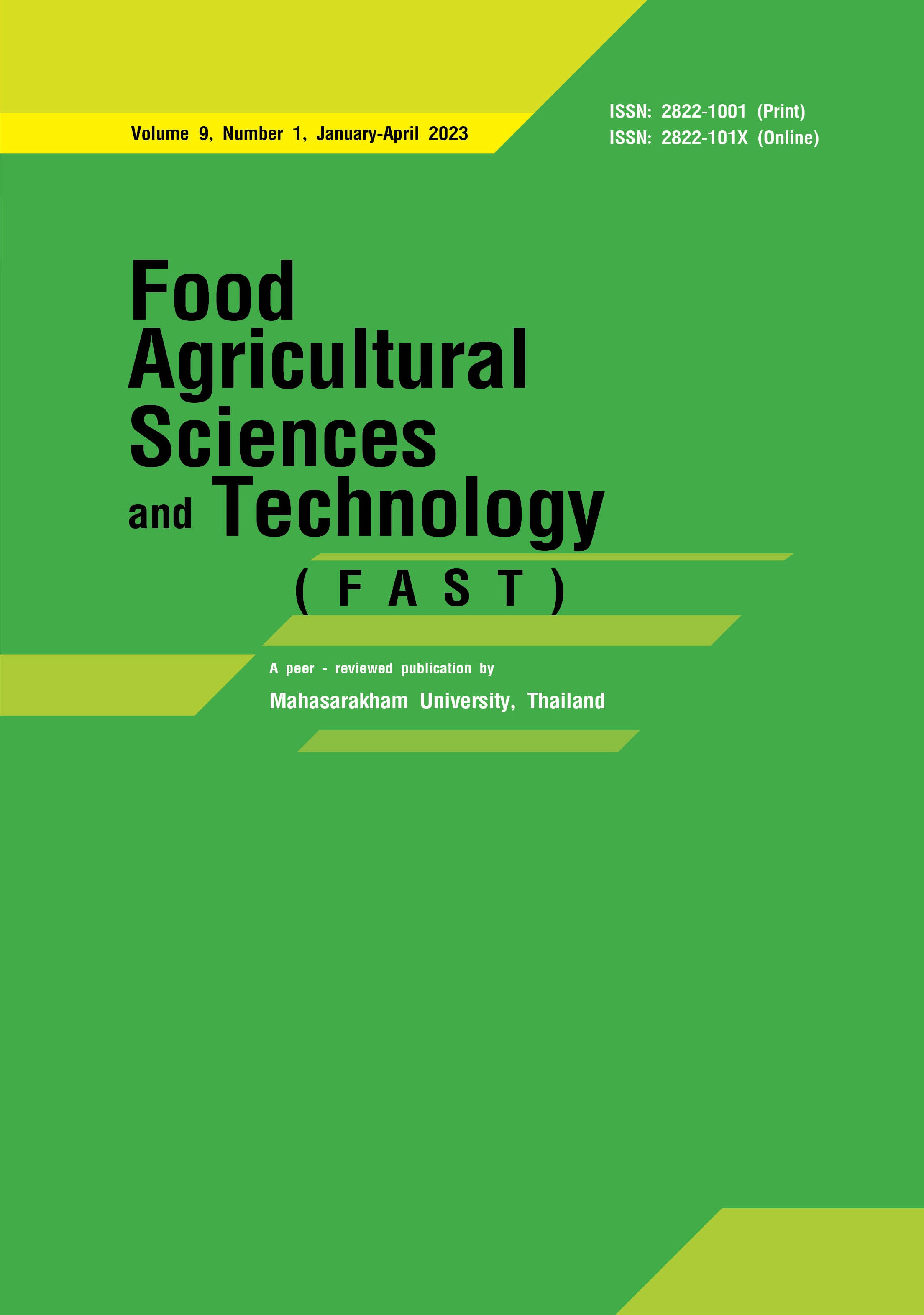Potential application of immobilized Bacillus subtilis (P5-6) as bio-protective culture against Staphylococcus aureus in acidic and salted food model
Keywords:
Bacteriocin, Bacillus, Protective culture, Gene expression, S. aureusAbstract
This research is aimed to apply bacteriocin-producing halophilic bacteria from salty fermented foods, B. subtilis (P5-6) against S. aureus as bio-control agent in bamboo shoot pickle. Expression of genes associated with bacteriocin activity of the B. subtilis (P5-6) was investigated. Only subtilin gene expressions were observed along with housekeeping gene
This research aimed to apply bacteriocin producing strain Bacillus subtilis (P5-6) as protective culture against Staphylococcus aureus in bamboo shoot pickle. Expression of genes associated with bacteriocin activity of the B. subtilis (P5-6) was investigated. Only subtilin gene expressions were observed along with housekeeping gene BA-rpoB when co-cultured with S. aureus. B. subtilis (P5-6) protective culture was made in a simple form as dried mango pieces containing 2.5 mg/g salt with viable count at 6.25 log CFU/g and water activity (aw) at 0.49, respectively. The Protective culture was made by immobilizing cells and culture of P5-6 in freeze-dried mango pieces and drying with two-step drying process. The Minimum Inhibitory Concentration (MIC) of the protective culture was 20 AU/mg and Minimum Bactericidal Concentration (MBC) at 80 AU/mg. When applied as bio-preservative in bamboo shoot pickle, the protective culture significantly (p<0.05) reduced the level of S. aureus contamination and had no impact on this food properties. This study demonstrated the potential of P5-6 in this simple protective culture form in controlling the growth of S. aureus, therefore it could be a potential for further development as bio-preservative to enhanced safety of food products.
References
Abriouel, H., Franz, C. M., Omar, N. B., & Gálvez, A. (2010). Diversity and applications of Bacillus bacteriocins. FEMS Microbiology Reviews, 35, 201-232.
Chhetri, V., Prakitchaiwattana, C., & Settachaimongkon, S. (2019). A potential protective culture; halophilic Bacillus isolates with bacteriocin encoding gene against Staphylococcus aureus in salt added foods. Food Control, 104, 292-299.
De Vuyst, L. (2000). Technology aspects related to the application of functional starter cultures. Food Technology and Biotechnology, 38, 105-112.
Farber, J., & Peterkin, P. (1991). Listeria monocytogenes, a food-borne pathogen. Microbiological Reviews, 55, 476-511.
Halling, S. M., Burtis, K. C. & Doi, R. H. (1978). β′ subunit of bacterial RNA polymerase is responsible for streptolydigin resistance in Bacillus subtilis. Nature, 272, 837-839.
Hennekinne, J.A., De-Buyser, M.L., & Dragacci, S. (2012). Staphylococcus aureus and its food poisoning toxins: characterization and outbreak investigation. FEMS Microbiology Reviews, 36(4), 815-836.
Kadariya, J., Smith, T. C., & Thapaliya, D. (2014). Staphylococcus aureus and staphylococcal food-borne disease: an ongoing challenge in public health. BioMed Research International, 2014.
Klein, C., Kaletta, C., & Entian, K. (1993). Biosynthesis of the lantibiotic subtilin is regulated by a histidine kinase/ response regulator system. Applied and Environmental Microbiology, 59, 296-303.
Ko, K. S., Kim, J.-W., Kim, J.-M., Kim, W., Chung, S.-I., Kim, I. J. & Kook, Y.-H. (2004). Population structure of the Bacillus cereus group as determined by sequence analysis of six housekeeping genes and the plcR gene. Infection and Immunity, 72, 5253-5261.
Leroy, F., Moreno, M. F. & De Vuyst, L. (2003). Enterococcus faecium RZS C5, an interesting bacteriocin producer to be used as a co-culture in food fermentation. International Journal of Food Microbiology, 88, 235-240.
Moraes, P. M., Perin, L. M., Ortolani, M. B. T., Yamazi, A. K., Vicosa, G. N., & Nero, L. A. (2010). Protocols for the isolation and detection of lactic acid bacteria with bacteriocinogenic potential. LWT-Food Science and Technology, 43, 1320-1324.
Rogers L. A. 1914; The preparation of dried cultures. J. infect. Dis, 14, 100.
Shin, M., Han, S., Ryu, J., Kim, K., & Lee, W. (2008). Isolation and partial characterization of a bacteriocin produced by Pediococcus pentosaceus K23-2 isolated from Kimchi. Journal of Applied Microbiology, 105, 331-339.
Stein, T. (2005). Bacillus subtilis antibiotics: Structures, syntheses and specific functions. Molecular Microbiology, 56, 845-857.
To Truc Anh, H., Chhetri, V., Settachaimongkon, S. and Prakitchaiwattana, C. (2021). Stress tolerance-Bacillus with a wide spectrum bacteriocin as an alternative approach for food bio-protective culture production. Food Control, 133, A, 108598.
Woraprayote, W., Malila, Y., Sorapukdee, S., Swetwiwathana, A., Benjakul, S., & Visessanguan, W. (2016). Bacteriocins from lactic acid bacteria and their applications in meat and meat products. Meat Science, 120, 118-132.
Downloads
Published
How to Cite
Issue
Section
License
Copyright (c) 2023 Food Agricultural Sciences and Technology (FAST)

This work is licensed under a Creative Commons Attribution-NoDerivatives 4.0 International License.








